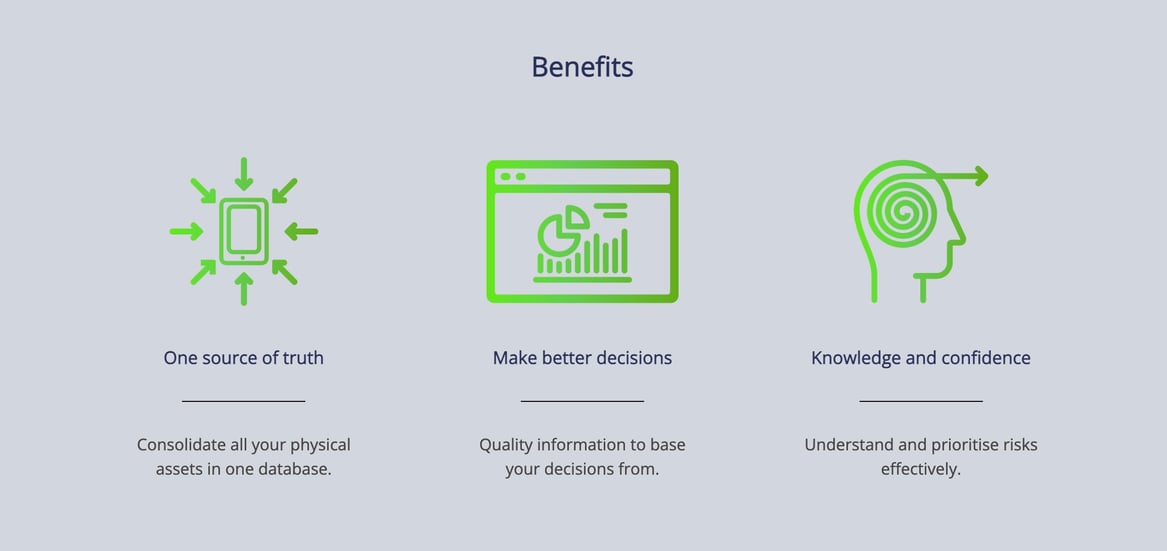Why your asset management data is at risk if you’re using spreadsheets

Spreadsheets may feel safe, easy and familiar, but they actually put your asset management data at risk, as they’re not secure; can be shared; become reliant on one person, or are simply inaccurate. Here’s the low-down on spreadsheet risk – and what to do about it.
Some things in life feel safe, familiar, and easy. You may think we mean your fluffy slippers, your cosy-but-worn hoodie, or fish ‘n’ chips for dinner. But no – we’re talking spreadsheets. And let’s face it: spreadsheets are familiar and easy to use. They’re also cheap because you’ve already got the software.And that’s why many asset registers came into being as spreadsheets, as they’re the easiest and cheapest way to store asset management data.
But then the spreadsheet grew...
That initial asset register spreadsheet has likely grown and grown over time. From ten rows of data to hundreds, then thousands. Maybe you’ve even put it on the cloud so colleagues can collaborate.
Not only that, but new asset data may have come into the organisation via a spreadsheet or PDF. So that’s been added too.
Maybe you’re still happy with the spreadsheet. Or maybe you’re beginning to experience some hiccups and niggles with it. One thing is for sure: these problems will only amplify if you’re using a simple, comfortable tool for a much bigger purpose, such as asset management planning.
Just like you wouldn’t wear your favourite hoodie to a board meeting, as it’s not fit for purpose, spreadsheets aren’t suitable for complex asset registers. There’s a whole lot of risk involved in using spreadsheets for asset management purposes.
3 important reasons why spreadsheets are risky for your asset management data
1. Data integrity is at risk
Have you ever typed the wrong kind of information into the wrong cell? For example:
- Inputting numbers into text fields.
- Spelling errors, resulting in different names for the same asset.
- Corrupting data through incorrect copying and pasting.
- Making a typo in a formula.
It’s very easy to make these kinds of errors – and they may go unnoticed for a long time. Yet it takes only a minimal amount of data errors before the integrity of all the data has been compromised.
What happens then is a reduction in confidence in that data, and in the outputs. When data becomes compromised, organisations will very quickly lose the assurance needed for effective decision-making.
A study found that:
- 90% of spreadsheets with 150 rows or more contain errors;
- 94% of shared spreadsheets contain errors.
What that means is that the resulting data is inaccurate, which causes a chain reaction, giving all stakeholders the wrong asset information – information they'll be using to make critical decisions around asset management.
2. The single-person dependency of spreadsheets creates knowledge silos
When people use spreadsheets, they tend to develop their own links, formulae, charts, and even macros, creating a single-person dependency. When the spreadsheet creator gets sick, goes on holiday, or leaves the organisation, their knowledge of that automation goes with them. If that knowledge isn't passed on, it can cause severe problems; specifically, a reduction in the quality of data, especially when spreadsheet macros require editing.
The asset management process should never be reliant on a spreadsheet that's dependent on an individual with multiple manual touch points.
If someone who plays a key role in asset management goes on holiday, falls ill, or resigns, the asset management process should still continue. It’s a mistake to rely on one individual and their spreadsheet – to have that single-person dependency – when it comes to asset management. After all, most organisations have an obligation to provide reliable information on demand to their various stakeholders.
Not only that, but a significant amount of time may be wasted trying to decrypt a spreadsheet, or recovering data and information. This time should be focused on more high-value tasks.
David Long, General Manager of SPM Assets New Zealand, says: "I’ve seen it happen again and again, where organisations have spreadsheets that hold all their asset information management data, but they can't get meaningful data out, because it's either corrupt or hidden away. They inevitably get trapped in an ongoing data improvement loop."
3. Spreadsheets create a security risk
While security layers can be built into spreadsheets, they require a fairly high level of knowledge and sophistication. And if certain areas of the spreadsheet are password protected, organisations run the risk of not being able to access it if the person with the password is absent. Even cloud-based spreadsheets, with multiple collaborators, are a security risk.
In a nutshell: spreadsheets are easy to corrupt, and difficult to protect.
There’s also the security exposure of individuals emailing spreadsheets around an organisation. This can lead to the inadvertent release of sensitive data to outside recipients.
Not only that, but configuration control becomes an issue when spreadsheets are emailed around an organisation. What happens, multiple versions of the spreadsheet are created. There is no longer a master spreadsheet, but different versions with different data added or edited. Fixing up those sorts of issues is an unnecessary and time-consuming headache.
What’s the alternative to spreadsheets in asset management?
So if you’ve outgrown your cosy, comfortable (and possibly corrupted) asset register spreadsheet – what do you do?
The answer is to use fit-for-purpose asset management software, as provided by such as SPM Assets.
In terms of your asset register, it creates a single source of truth allowing you and your team to make better quality decisions because it’s based on accurate data. This, in turn, gives you confidence in your future planning.

And it’s so much more than just an asset register, too. Asset management software can help you with:
Making the move is easy
Making the move from spreadsheets to fit-for-purpose asset management software is easier and quicker than you may think.There’s a case study of Hastings District Council, where SPM Assets set up the asset management software overnight for a pilot project, with an off-the-shelf template for local government. That included component names, replacement rates, useful lives, criticality factors, and deterioration models. Then, after a pilot exercise, all existing historical data that was held in council spreadsheets was filtered, mapped, and added to the asset database.
With an experienced team who are specialised in this work, the transition is structured, efficient, and effective.
Why it’s more important than ever to have data you can trust
Industries, corporations, and organisations are still navigating their way around the post-COVID-19 era. It’s about working smarter, and technology is a big part of that.
And with a backdrop of record high levels of inflation, it’s more important than ever to have data you can trust, that’s up-to-date.
Next step
Contact us if you have any questions about moving on from spreadsheets, or any other aspect of property asset management planning.
Subscribe to our Broadcast
Our monthly newsletter featuring asset management tips and insights, and the latest SPM Assets news.